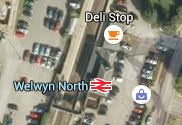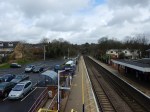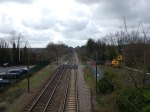Could We Just Double The Width Of The Digswell Viaduct?
The Digswell Viaduct and the associated double-track railway through Welwyn North station at its northern end, on the East Coast Main Line is probably one of the biggest bottlenecks on railways in the UK. Wikipedia says this about the Grade II* Listed viaduct.
The viaduct carries the East Coast Main Line, which has to narrow from four tracks to two to cross the viaduct, making it a bottleneck restraining capacity over this strategic transport route. This problem is exacerbated by Welwyn North railway station situated at the northern end of the viaduct, which blocks the line while trains are stationary and two tunnels to the north. Several ideas to overcome the limitations of the viaduct and station without damaging the viaduct’s essential historic character and rhythmic design are periodically discussed. The line was electrified in the 1970s.
Various plans have been put forward to remove the bottleneck cause by this masterpiece of Victorian engineering.
The Current Capacity
Network Rail have published this report, which is entitled The Capacity Of The Welwyn Viaduct. This is said about the capacity of the twin-track section.
The two track section between Woolmer Green Junction and Digswell contains both Welwyn Viaduct and Welwyn Tunnel and is approximately 2.5 miles in length.
In pure theoretical terms the capacity of the viaduct is dictated by the headway over the section.
There is a planning headway of 3 minutes over the two track section which therefore results in a theoretical maximum capacity of 20 trains per hour. To achieve this capacity would require a fully homogeneous service (for example same rolling stock and calling patterns) and 100% use of planning capacity.
The usable capacity is below the theoretical and is determined by the service specification which needs to use the capacity. The current and future specifications for the section require calls at Welwyn North Station which is on the two track section. This reduces the number of paths that can be achieved in a single hour over the viaduct. The usable capacity is also determined by the fast line capacity between Finsbury Park and Digswell and the difference in speed of rolling stock approaching the two track section which will determine whether trains can be flighted over the viaduct at 3 minute slots to achieve the theoretical capacity.
There is no defined permitted number of paths on the viaduct as the capacity available is a function of demand and therefore the type and number of services which need to use it.
Network Rail concludes that eighteen trains per hour is a theoretical maximum on the current track layout.
Reason For Removal Of The Bottleneck
Whether or not HS2 is built, the East Coast Main Line must be improved to handle the large and ever growing traffic between London and Leeds, Newcastle and Edinburgh.
If more of the line was four-track, it would make the train companies aim of a frequent four-hour service to Edinburgh achievable. It could be even faster, if a lot of the line could handle trains at one hundred and forty mph, rather than the current one hundred and twenty-five.
Proposed developments are detailed in Wikpedia.
One of the most important is removing the bottleneck at Welwyn.
One Problem Or Two?
I think that when outsiders look at this bottleneck, they see one problem, but I think it is fair to describe it as two.
- Welwyn North station and the tunnels to the North.
- The Digswell Viaduct itself
In my view both problems need their own solutions.
We shouldn’t also forget other smaller changes, that can take the pressure of the area.
- More and better use of an upgraded Hertford Loop Line.
- More precise and better timetabling of trains.
- As Thameslink beds down, we’ll see other improvements.
I also wonder, if a fully-electrified freight route could be created between Peterborough and London, through March, Ely and Cambridge, that used the extra capacity of a four-tracked West Anglia Main Line.
Welwyn North Station
In some ways the station is as big a bottleneck as the viaduct, as the two trains an hour that stop in the station, effectively block the line for a few minutes.
It is also one of those heritage problems, that Network Rail love so much. This is said in the Wikipedia entry for the station.
The station is a rare survival of architecture from the early days of the GNR and this is now recognised with listed building status. The main station building, the footbridge, the tunnel portal to the north and Welwyn Viaduct to the south are all Grade 2 listed.
So I doubt that modifying the station will be easy.
This Google Map shows the lines through the station.
These are some pictures of Welwyn North station taken on another day.
The images, probably shows another problem in that four-tracking the line through Welwyn North station would probably close the car parks.
The Digswell Viaduct
The Digswell Viaduct is an iconic structure and if the views of the viaduct and the valley it crosses were to be altered in any negative way, there would be a battle that would make the protests over HS2 look like a child’s tea party.
Around 1890, they had a similar capacity problem at the Stockport Viaduct, which was successfully widened from two tracks to four.
It is my view, that with major advances in structural engineering and construction methods, that widening the viaduct would be one of the better methods to improving the capacity through the area, without changing the look of the viaduct.
Intriguingly, if the East Coast Main Line was not already electrified, with the recent development of IPEMU-technology, I suspect now that Network Rail would think seriously about not electrifying the viaduct.
Trains would cross using their on-board energy storage, raising and lowering their pantographs appropriately.
Knebworth Station
This Google Map shows Knebworth station, a few miles to the North of Welwyn North.

This station has four platforms arranged on two islands.
For comparison, this is an image of Welwyn North station to the same scale.

I think that four-tracking Welwyn North station will be a tight fit.
Comclusion
At some point, I feel that Network Rail will bite the bullet on four-tracking this section of line and the fight will be a big one.













Ah, “just”. The wallpaper word.
Apparently to cure damp at Lincoln cathederal, someone suggested “just put a waterproof membrane under it”.
Comment by Conrad McMahon | July 23, 2018 |
Probably the easiest compromise at Welwyn North station would be to opt for three tracks, instead of trying to get four tracks in. This would avoid too much of the car park being lost. An additional track would at least allow trains to pass when one was stopping at a station. I’ve no idea if it would be possible to squeeze a third track into the existing tunnels though, and similarly whether they’d be allowed to add a third track to one side of the viaduct.
Comment by Keith | July 31, 2019 |
The more I look at this problem, the more I believe that the following should be done.
1. Upgrade the Hertford Loop Line for faster running and add digital signalling.
2.Build a large Parkway station South of Stevenage on the Hertford Loop Line.
3.Make sure the new platform at Stevenage for Moorgate services can handle six trains per hour (tph).
4. Run six tph from Moorgate to Welwyn Garden City.
5. Update between Alexandra Palace and Moorgate with digital signalling for sixteen tph.
6.Update Moorgate station if necessary, but I suspect Crossrail covers it.
7. Run all Cambridge, Kings Lynn and Peterborough services with 125 mph trains.
8. Electrify Peterborough to Cambridge.
9. Reopen March and Spalding via Wisbech to get freight off the ECML.
10. Four track the West Anglia Main Line and run at least half-hourly Liverpool Street and Peterborough services via Stansted and Cambridge.
11.Close Welwyn North station.
12. Run a Leeds and Cambridge service via Peterborough, Doncaster Sheffield Airport and Doncaster with 125 mph trains.
Two tracks over Digswell and the closed Welwyn North station will just have to cope!
Comment by AnonW | July 31, 2019 |
Diverge the through lines a few miles south of Digwell Viaduct, through tunnels and new viaduct and tunnels to emerge… just south of Stevenage. Completely circumvent Welwyn North Station by going under in tunnels.
This divergence should be future-proofed by being a four track by-pass of the bottleneck section making the existing a divergence from what would be the ECML Fast and Very Fast up / down tracks.
Comment by Michael | June 18, 2021 |
My idea would be to rebuilt Welwyn North station on a heritage railway and build a new four platform station with the lines over Digswell viaduct beaning made six tracks to let there be two freight long loops at 6 miles long each with a 55 MPH speed limit. The slow lines would have 110 MPH speed Limit and the Fast 140 MPH with ETCS signalling and extended the Northern City Line to bank with two platforms on different balloon loops with the tunnels being made with a dimeter of 10 meters and make all platforms able to take 20 coach trains with service’s between bank / Kings Cross and Alexandra place able to take 20 coach trains with the trains splitting at Alexandra place with 12 coaches going on the ECML and 8 coaches on the Hartford loop with the Hartford loop have line speeds raised as high as possible up to 110 MPH and the fitting of ETCS.
Comment by joshua | June 20, 2021 |
I think what should be done is to widen the Digswell Viaduct board to allow for 4 lanes. In many bridges in the world it is done maintaining the original structure, it is only necessary to verify that the structure (pillars and arches) can support the extra weight and I believe that it can without problems, since the old bridges are actually made to support much more weight than they really bear. The most radical example is that of the Roman bridges, which were made to pass horse-drawn carriages and in many cases have been used to build highways over them.
On the other hand, the tunnels, which would require new parallel tunnels to allow two extra tracks.
The extension to 4 tracks of Welwyn North Station is the easiest of all. If there is no space for parking, it can be done underground.
Once this is done it would be advisable for trains currently terminating at Welwyn Garden City to be extended to Stevenage, which already has a 5th track terminus for trains coming from the Hertford branch and a 6th track could be added for trains coming from Welwyn Garden City.
Comment by BRJ36 | July 13, 2023 |